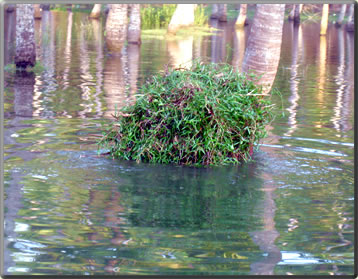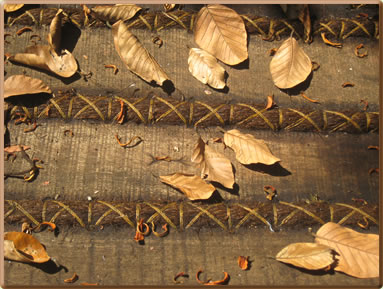
 A backwater exploration of village waterways near Kollam includes meeting local people and learning about traditional practices.
A backwater exploration of village waterways near Kollam includes meeting local people and learning about traditional practices.

Story and photos by Alison Gardner, Editor, Travel with a Challenge
Kerala state stretches for about 360 miles/580 kilometers along the Malabar coast on the southwestern side of the Indian peninsula; its width varies from 20 to 75 miles across. With only 3.43% of the country’s vast population, Kerala is an educationally-advanced state with its own language, Malayalam, and has the highest rate of literacy (100%) among Indian states. Kerala state is most famous among vacationers for its natural inland waterways fed by an amazing 44 rivers and for its manicured tea plantations that decorate the hill country of the Western Ghat Mountains.
 The backwaters of Kerala are made up of over 560 miles/ 900 kilometers of interconnected natural canals, rivers, lakes and inlets that parallel the Arabian Sea coastline. Traditionally used as transportation arteries, these backwaters now offer a rare experience for both domestic and international tourists visiting Kerala. Kerala’s innumerable waterways are almost entirely monsoon fed, meaning they fluctuate in size from small rivulets at times to overwhelming volumes in the wettest part of the rainy season (June to August). The National Geographic Society has listed Kerala among its “Lifetime 50 Destinations”.
The backwaters of Kerala are made up of over 560 miles/ 900 kilometers of interconnected natural canals, rivers, lakes and inlets that parallel the Arabian Sea coastline. Traditionally used as transportation arteries, these backwaters now offer a rare experience for both domestic and international tourists visiting Kerala. Kerala’s innumerable waterways are almost entirely monsoon fed, meaning they fluctuate in size from small rivulets at times to overwhelming volumes in the wettest part of the rainy season (June to August). The National Geographic Society has listed Kerala among its “Lifetime 50 Destinations”.
There is something quite special about arriving, fully laden with luggage, at a holiday resort in a small canopied boat, an arrival made all the more intriguing when it includes a 15-minute ride along palm-fringed canals with sacred cows grazing and children waving and splashing, neither cows nor kids with a care in the world. Heading for the Poovar Island Resort private dock, I am mindful of being very close to the southernmost tip of India where in 1036 BC, according to legend, King Solomon’s ships docked in a port called Ophir (now called Poovar) to trade in spices, sandalwood and ivory. This is a very ancient part of the world that I am about to experience.
 Motorized water taxis offer efficient transport to backwater resorts.
Motorized water taxis offer efficient transport to backwater resorts.
With environmental impact in mind, the resort recommends patronizing backwater tour operators who pole their long wooden fishing canoes (as they stand like Venetian gondoliers) around a magical watery landscape for early morning birding expeditions, botanical explorations any time of day or a golden sunset cruise. Not only is this kinder to the shoreline and passing canoes than boats with engines making waves that erode banks and contribute to carbon emissions in the fragile ecosystem, but also canoe travel results in more close-up glimpses of undisturbed wildlife along the less-traveled channels.
 Undeterred by rising water, a backwater resident disappears under the fodder he is carrying home to feed his animals.
Undeterred by rising water, a backwater resident disappears under the fodder he is carrying home to feed his animals.
 Kerala boatman, Braifin, uses a traditional wood canoe inherited from his grandfather to take guests for early morning bird-watching trips and sunset cruises on a variety of backwater adventures.
Kerala boatman, Braifin, uses a traditional wood canoe inherited from his grandfather to take guests for early morning bird-watching trips and sunset cruises on a variety of backwater adventures.

Upon arrival, I had noticed a cream-colored sandbar less than five minutes by boat over to the canal shoreline opposite the resort. “Any time you want to cross to the public beach, just walk down to the dock and one of our boat drivers will take you to the beach facing the Arabian Sea,” my personal Guest Relations Executive had said. But the caution was instant and urgent, “You cannot swim there, the currents and waves are too dangerous!” Neither was swimming in the canals encouraged, again because the currents are unpredictable … certainly not to the seasoned local fishermen but at least to us visitors.
![]()
 While much of the resort is on dry land, some accommodation is on stilts connected by boardwalks.
While much of the resort is on dry land, some accommodation is on stilts connected by boardwalks.
Kerala is known for its excellence and authenticity in Ayurveda medical practices, a system of medicine that evolved in India thousands of years ago. Its focus is on preventing disease as well as treating particular ailments.
One reason I selected Poovar Island Resort was to learn about its Ayurveda Health Village, a separate 15-room element of the resort property with two Ayurvedic doctors, 13 treatment rooms, numerous massage practitioners, its own Ayurvedic restaurant heavy on fruits and vegetables, its own swimming pool, and a serious commitment to curing or relieving health problems such as joint pain, obesity and chronic stress. Minimum check-in is one week for rest and relaxation clients with no medical agenda, two weeks for clients with medical challenges.
 At the end of a working day, the two doctors from Poovar Island Resort`s Ayurveda Health Village head home by canoe taxi.
At the end of a working day, the two doctors from Poovar Island Resort`s Ayurveda Health Village head home by canoe taxi.
Having only three days in this lovely part of Kerala and sleeping outside the health and wellness village elsewhere on the resort property, I was still able to book Ayurveda massage appointments, accessed with a five-minute stroll along wooden boardwalks on stilts over the water and through manicured Ayurveda Village gardens where clients are encouraged to relax rather than strenuously exercise – but NOT sleep! – between treatments and daily consultations.
Early morning yoga sessions are offered on the lawn and leisurely canoe excursions are a rejuvenating way to begin or end the day. A relaxed, smiling Dr Ajith Kumar reassured me, “There are no Ayurveda police here!” He is one of two consulting physicians who have worked there for 12 years. Poovar Island Resort’s chief international clientele in more than a decade of operation has been European, especially when it comes to the Ayurveda Village.
To health-oriented Germans, Swiss and Swedes, two or three weeks of focus on retaining or regaining a healthy life balance in such a beautiful, undistracted setting is motivation enough. Many British retirees come for a month or two annually to escape the worst of winter in the UK, mostly with leisure on their minds. And, of course, the Indian middle class, now 350 million strong across the country, is becoming an increasingly important clientele, particularly in the shoulder seasons.
 Poovar Island Resort’s floating cottages are a popular visitor choice along the property’s waterfront.
Poovar Island Resort’s floating cottages are a popular visitor choice along the property’s waterfront.
![]()
Later in my Kerala visit, I journeyed to Kollam, 71 kilometers/44 miles north of the state capital, Thiruvananthapuram (or for those of us intimidated by an 18-letter name, Trivandrum). By Indian city standards a mere “town” of 350,000, Kollam has been a center of culture and learning for centuries as well as the southern gateway to the backwaters. Checking in at the tourism office, where almost all city area tours are arranged anywhere in Kerala, I learned about a village canoe tour on the outskirts of the city. In fact, it was an hour’s hard driving mostly on unpaved backroads in the tourism bus before we arrived at our canal embarkation point in a traditional thatched, wood and brick village with a great deal of canal-front shoreline.

A Kollam village canal cruise.
 Sculpted from durable hardwood timber, Kollam’s canoes have intricate, decorative caulking that efficiently deters leaks between boards.
Sculpted from durable hardwood timber, Kollam’s canoes have intricate, decorative caulking that efficiently deters leaks between boards.
We set off in two slim hardwood canoes for a tour of the village and its surrounding forests and farmland. Disembarking at various points of interest, we met both women and men keen to demonstrate their daily activities and invite us in for a chat and a drink. Here was a more intimate landscape compared with the vastness and wilderness of the Poovar waterways.
There seemed to be plenty of maintenance required to ensure that canal banks stayed put and that trees did not droop too close to the canoes. We even had to duck smartly under the occasional stone bridge as we noted a wide variety of citizens’ homes, observed fish farming ponds covered in fine-mesh nets to protect against feasting by fish-loving birds, and we peaked into cultivated bank-side gardens planted with a healthy collection of fruit and vegetables for daily picking.
Keralans proudly declare their state to be “God’s own country” which, at least in the context of India’s relentless press of daily economic and social challenges, may very well be true. With 100% literacy, a healthcare system that boasts India’s lowest infant mortality and highest life expectancy rates, and an enviable physical quality of life, it is blissfully peaceful outside the few cities, incredibly green and still relatively pristine. Nowhere better do I feel that the people of Kerala have something special to model to the rest of us than when I am meandering along in a well-poled canoe, or having hot oil drizzled on my brow during a brief encounter with the world of Ayurveda.
 The backwaters are rich in marine and bird wildlife such as this aptly-named snakebird.
The backwaters are rich in marine and bird wildlife such as this aptly-named snakebird.
![]()
Poovar Island Resort, www.poovarislandresort.com, is owned by Aitken Spence Hotels & Resorts, www.aitkenspencehotels.com, which has developed an original collection of heritage restorations and environmentally-sensitive properties in Sri Lanka, India, Maldives and Oman.
Kerala Tourism information website: www.keralatourism.org.
When to go – take your choice! High Season is December to May; Monsoon “Rejuvenation” Season is June to November; “Dream” Season is April to September [titles courtesy of Kerala Tourism].
Alison Gardner is a travel journalist, magazine editor, guidebook author, and consultant. She specializes in researching vacations throughout the world, suitable for people over 50 and for women of all ages. She is also the publisher and editor of Travel with a Challenge Web magazine. Email: alison@travelwithachallenge.com.
